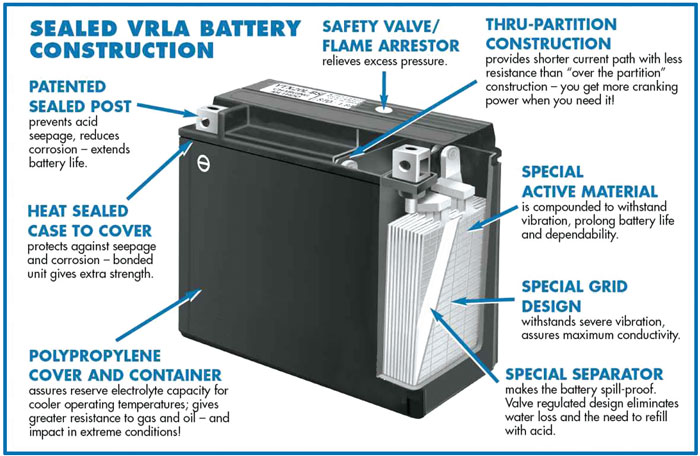lead–acid battery
The lead–acid battery was invented in 1859 by French physicist Gaston Planté and is the oldest type of rechargeable battery. Despite having a very low energy-to-weight ratio and a low energy-to-volume ratio, its ability to supply high surge currents means that the cells have a relatively large power-to-weight ratio. These features, along with their low cost, makes it attractive for use in motor vehicles to provide the high current required by automobile starter motors.
A VRLA battery (valve-regulated lead-acid battery), more commonly known as a sealed battery or maintenance free battery, is a type of lead-acid rechargeable battery. Due to their construction, they can be mounted in any orientation, and do not require constant maintenance.
There are two primary types of VRLA batteries, gel cells and AGM. Gel cells add silica dust to the electrolyte, forming a thick putty-like gel. These are sometimes referred to as “silicone batteries”.
AGM (Absorbed glass mat)
AGM batteries differ from flooded lead acid batteries in that the electrolyte is held in the glass mats, as opposed to freely flooding the plates. Very thin glass fibers are woven into a mat to increase surface area enough to hold sufficient electrolyte on the cells for their lifetime. The fibers that compose the fine glass mat do not absorb nor are they affected by the acidic electrolyte. These mats are wrung out 2–5% after being soaked in acids, prior to manufacture completion and sealing.
The plates in an AGM battery may be any shape. Some are flat, others are bent or rolled. AGM batteries, both deep cycle and starting, are built in a rectangular case to BCI battery code specifications.
Gel battery
Originally a kind of gel cell was produced in the early 1930s for portable valve (tube) radio LT supply (2, 4 or 6V) by adding silica to the sulfuric acid.[5] By this time the glass case was being replaced by celluloid and later in 1930s other plastics. Earlier “wet” cells in glass jars used special valves to allow tilt from vertical to one horizontal direction in 1927 to 1931 or 1932.[6] The gel cells were less likely to leak when the portable set was handled roughly.
A modern gel battery (also known as a “gel cell”) is a VRLA battery with a gelified electrolyte; thesulfuric acid is mixed with fumed silica, which makes the resulting mass gel-like and immobile. Unlike a flooded wet-cell lead-acid battery, these batteries do not need to be kept upright. Gel batteries reduce the electrolyte evaporation, spillage (and subsequent corrosion problems) common to the wet-cell battery, and boast greater resistance to shock and vibration. Chemically they are almost the same as wet (non-sealed) batteries except that the antimony in the lead plates is replaced by calcium, and gas recombination can take place.
Deep-cycle AGMs are also commonly used in off grid solar power and wind power installations as an energy storage bank and in large-scale amateur robotics, such as the FIRST and IGVC competitions.

